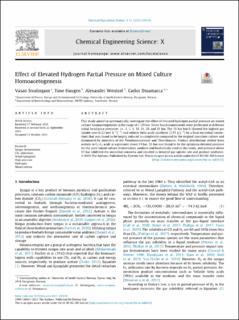Effect of Elevated Hydrogen Partial Pressure on Mixed Culture Homoacetogenesis
Peer reviewed, Journal article
Published version
Permanent lenke
https://hdl.handle.net/11250/2978054Utgivelsesdato
2021Metadata
Vis full innførselSamlinger
Originalversjon
Sivalingam, V., Haugen, T., Wentzel, A. & Dinamarca, C. (2021). Effect of Elevated Hydrogen Partial Pressure on Mixed Culture Homoacetogenesis. Chemical Engineering Science: X, 12, Artikkel 100118. https://doi.org/10.1016/j.cesx.2021.100118Sammendrag
This study aimed to systematically investigate the effect of elevated hydrogen partial pressure on mixed culture homoacetogenesis in the range of 1–25 bar. Seven batch experiments were performed at different initial headspace pressures, i.e., 1, 3, 5, 10, 15, 20, and 25 bar. The 15 bar batch showed the highest gas uptake rate (6.22 mol h−1L−1) and volatile fatty acids synthesis (3.55 g L−1) by a final microbial consortium that was found to be largely reduced in complexity compared to the original inoculum culture and dominated by members of the Pseudomonadaceae and Clostridiaceae. Product distribution shifted from acetate to C3-C5 acids at a pressure above 15 bar. 15 bar was found to be the optimum elevated pressure for the used mixed culture fermentation medium and biodiversity used in this study, and pressure above 15 bar inhibited the microbial consortia and resulted in lowered gas uptake rate and product synthesis.

